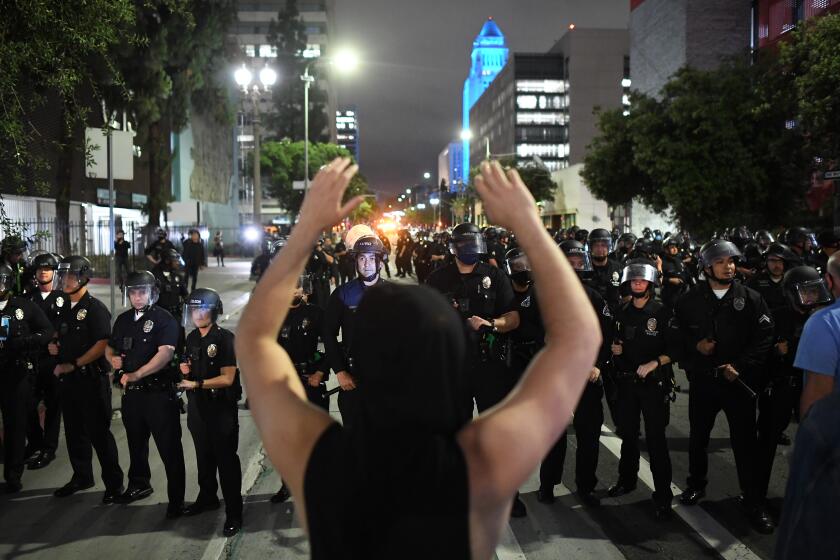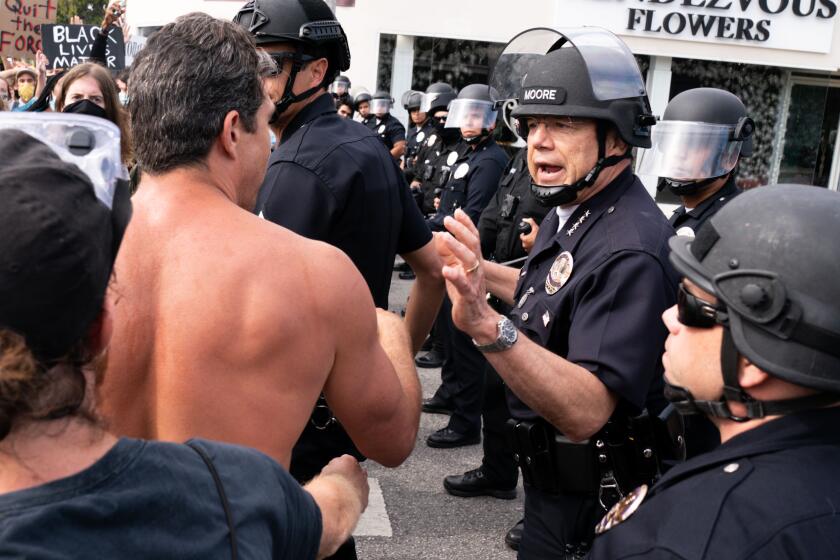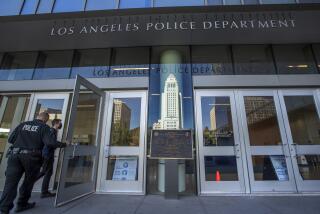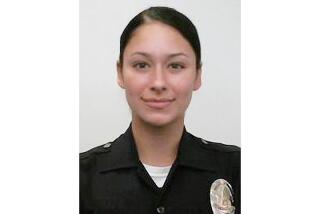Fatal shootings by the LAPD are down, but officials find major problems in many incidents
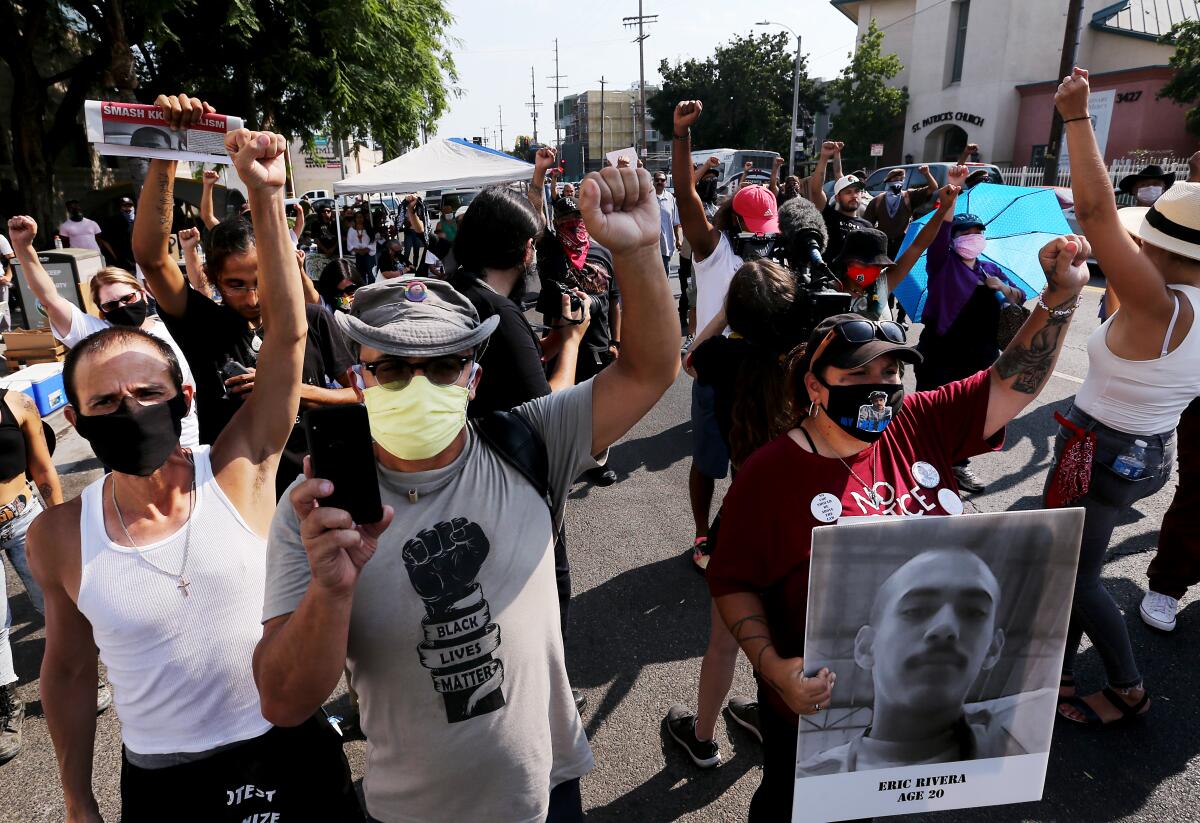
- Share via
The number of people fatally shot by Los Angeles Police Department officers has decreased in recent years, but the civilian body that oversees the department has found that officers’ actions were significantly flawed in a majority of the cases.
The Los Angeles Police Commission has faulted officers for firing unnecessary shots, failing to maintain effective communication with one another and failing to wait for reinforcements, among other things, a Times analysis of fatal shootings since 2018 shows.
While some of the mistakes likely did not change the outcome of the incident, others led to a fatal confrontation that might have been avoided or increased the chance of death for a civilian hit by multiple bullets.
The Times analysis, based on reports from the Police Commission and Chief Michel Moore, as well as video narratives compiled by the LAPD, adds to questions about whether the department could do more to prevent the killing of civilians.
The LAPD mishandled the unrest that erupted after the death of George Floyd, according to a new report commissioned by the City Council.
Most of the people shot by the LAPD in recent years were armed with a gun or a knife. But that did not prevent the commission from finding serious issues with officers’ actions.
Moore, who became chief in June 2018, said the department has admitted to mistakes and learned from them, using the commission’s findings as blueprints to avoid similar tragedies. The only acceptable number of fatal shootings is zero, he has said.
He attributes the decrease in fatal shootings — seven last year, compared with 21 in 2015 — in part to improved less-lethal options, such as Tasers and beanbag shotguns, as well as training in teamwork and de-escalation techniques.
He also pointed to policies adopted in recent years that aimed to reduce police shootings.
“Every incident we look at is with the desire to pull it apart and understand, how could we have avoided it?” Moore said.
**
The five Police Commission members, who are appointed by the mayor, base their findings on internal LAPD investigations. They usually, but not always, agree with the conclusions in the chief’s report.
The commission sets LAPD policy and has made the use of deadly force a last resort rather than a “reasonable” option.
Because of policies enacted by the commission in recent years, officers are judged on their use of de-escalation techniques such as moving away from the civilian, trying to talk to the person and waiting for reinforcements before resorting to deadly force.
The commission assesses the officers’ tactics leading up to fatal shootings and whether each shot fired was justified.
In nearly half the fatal shootings since 2018, the commission has ruled that officers’ tactics before they fired were significantly flawed, according to the analysis by The Times.
In 26% of cases, the deadly force was at issue, with the commission finding that at least some shots fired were not justified.
Some cases had issues with both the tactics and the deadly force.
Half of the 32 fatal shooting victims since 2018, excluding bystanders, had a gun, the analysis found. Another 38% had a knife or other edged weapon. More than 20% of the victims had fired their guns at officers.
Most of the shootings originated with a 911 call, often reporting someone carrying a weapon. Only a handful stemmed from a random encounter such as a traffic stop.
The shooting of Lady Gaga’s dog walker as he resisted being robbed of her two French bulldogs fit a broader crime trend raising alarm among LAPD officials: More robbery victims being shot.
As in other cities, there are racial disparities in who is killed by police.
Since 2018, 13% of people fatally shot by LAPD officers were Black, and 67% were Latino, according to data obtained by The Times, in a city that is 9% Black and 49% Latino.
David A. Klinger, who was an LAPD officer in the 1980s and is now a professor at the University of Missouri-St. Louis, said the preponderance of suspects who were armed is in line with national trends. But in Los Angeles, the number of fatal shootings of victims who had a knife or other edged weapon, as opposed to a more dangerous firearm, seems unusually high, he said. Those cases should be scrutinized to see whether the officers got close too quickly or made other mistakes that could be avoided with training, he said.
In one case, a November 2019 shooting involving a man with a knife, the officers “created the exigency for themselves,” Moore said in his report.
That morning, as people in South-Central headed off to work or school, Alex Flores was walking down the street with a knife in his hand. He was looking around in a paranoid manner and appeared to be high on drugs and mentally ill, according to a witness.
With bystanders nearby, Flores charged toward an officer, who fired five rounds at him from about 12 feet away, according to reports from Moore and the commission. Flores, 34, who was Latino, died at the scene.
The shots fired by Officer Steven Ruiz were in line with policy, the commission ruled. But it found that the officers who rushed to the scene should have called for reinforcements and developed a better plan for approaching Flores. Moore’s report reached the same conclusions.
In another case, 38-year-old Daniel Hernandez was clutching a box cutter last April 22 on a street in South-Central.
He rushed toward Officer Toni McBride, according to an LAPD video narrative and McBride’s testimony to investigators.
McBride, the daughter of a well-known LAPD union official, fired at Hernandez, who was Latino, from more than 30 feet away, as bystanders looked on.
In December, the Commission ruled 4-1 that McBride’s final two shots were not justified because Hernandez was already lying on the ground. Moore found all six shots to be justified.
For the LAPD, it will be another period of forced change brought on by investigations and several lawsuits after the summer protests.
The commission also found that McBride’s partner substantially deviated from department policy by failing to work with her as a team.
After the commission adjudicates a shooting, the chief recommends discipline, which can be downgraded by a review board and generally remains secret from the public because of state laws shielding police personnel records.
As it is elsewhere in the country, the legal standard to convict a police officer of killing a civilian is high, and prosecutors in L.A. County rarely bring charges.
**
The LAPD is known for having one of the country’s best officer training regimens, according to Geoffrey Alpert, a professor and policing expert at the University of South Carolina. With nearly 10,000 sworn officers, the LAPD’s dozen or fewer fatal shootings a year is “actually a very good record,” he said.
Rob Harris, who until recently was a board member of the Los Angeles Police Protective League, the union that represents rank-and-file officers, said officers need quality training to make the right choices.
All LAPD officers take a 10-hour use-of-force course that emphasizes de-escalation and use of less-lethal weapons through role-playing exercises. They regularly refresh their skills with simulators and other scenario-based training.
“‘Why didn’t the officer shoot him in the leg?’ The best snipers in the military don’t do that,” Harris said. “Why? Because you know, in a stress-induced situation like that, your blood flow changes, it gets shuttled to your internal organs, which means your fine dexterity movements are limited.”
Moore also emphasized the importance of training and said it would continue to be a priority. Sometimes, he noted, the difference between a situation going terribly wrong or resolving peacefully is “microscopic.”
Shane Murphy Goldsmith, who was a police commissioner from 2016 until last November, said solutions beyond training are needed to prevent civilians from getting into confrontations with officers in the first place.
“How do we invest in low-income communities of color, providing support and services and resources they need to thrive, so they’re not ending up committing crimes, getting into dangerous situations, carrying guns?” Goldsmith asked.
**
The killing of George Floyd last summer by Minneapolis police and the nationwide protests that followed have brought renewed focus on racial disparities in police violence.
Though police killings of unarmed people are relatively rare in Los Angeles, the most controversial cases in recent years have involved a Black man wrestling with an officer, then allegedly trying to grab the officer’s gun.
Report on LAPD’s handling of George Floyd protests describes “shadow teams,” lack of training and poor planning.
In Los Angeles, as in many U.S. cities, Black people are disproportionately involved in violent crime, as both victims and suspects — a complex problem stemming from long-standing inequities in education, housing, job opportunities and criminal justice.
To some experts, that explains why Black people are shot by police at higher rates, since many shootings are precipitated by a violent act or use of a weapon. Studies that attempt to isolate race in police shootings have reached varying conclusions, with some stating that it did not appear to make a difference.
But assuming a shooting is justified because the suspect was armed or ran from the police is simplistic and does not account for the racial bias ingrained in policing, said Melina Abdullah, a co-founder of Black Lives Matter-Los Angeles. The way to reduce police shootings is not better-trained officers or more officers who build ties with community members but fewer officers, she said.
**
Reports from Moore and the Police Commission, as well as video narratives produced by the LAPD from officers’ body cameras and other footage, provide a detailed look at the events leading up to shootings — and sometimes, how officers might have acted differently.
On Aug. 19, 2019, Carlos Torres Jr., 39, stood at the front door of his parents’ house in Arleta, chatting warily with a police officer.
Nearby, Torres’ father told another officer that his son had been threatening him and often carried a gun.
As the officers’ body cameras rolled, Torres Jr. suddenly pulled a handgun from his waistband and fired. The officers shot back in rapid volleys.
Torres Jr. fled down the street. The officers ran after him, unleashing a barrage of bullets.
In an alley, Torres pointed his gun at another officer who had just pulled up. The officer fired a single shot, and Torres slumped to the ground, fatally wounded.
The Police Commission ruled that the shot that killed Torres, who was Latino, was justified. But the commissioners found fault with the first two officers’ actions. The officers, Adiel Herrera and Raul Hernandez, should have sought out Torres’ father, who was waiting by his car, before knocking on the door, the commission said. If they had done so, they would have known about Torres’ threatening behavior in time to withdraw, call for backup and devise a plan for approaching safely.
The commission also found that three shots from one of the officers — out of the 33 he and his partner fired — were not necessary, because Torres was turning away or running away.
The fatal shot by a gang enforcement officer, Miguel Zendejas, was justified, the commission ruled. A report by Moore came to the same conclusions.
The three officers who shot at Torres did not return emails seeking comment.
After more than a decade in prison for assault with a firearm, Torres did well at first, living with various relatives who helped him find jobs, according to his younger brother Manuel Torres. But he became increasingly paranoid and was using drugs after moving in with his parents. Afraid of their son and the gun he often tucked into his waistband, the parents had not set foot in their own house for weeks before the shooting.
Carlos Torres Sr. believes his son’s killing could have been avoided.
“What happened in the alley — they could have talked to him,” he said. “They shot to kill, not to talk.”
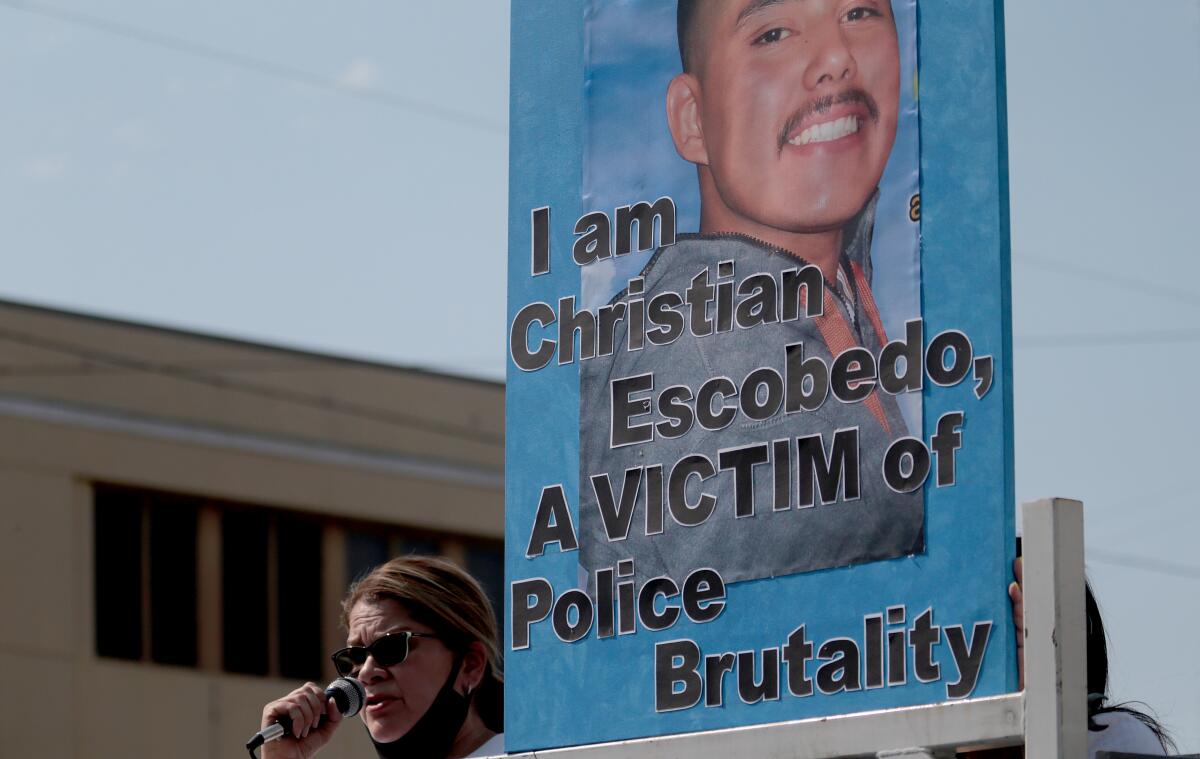
Elizabeth Escobedo also wonders whether there was something an LAPD officer could have done to avoid fatally shooting her son.
Christian Escobedo was walking home from a party Jan. 14, 2018, when he and a friend stopped for a nap in a driveway in Montecito Heights.
Officers responded to a report that one of the men appeared to have a gun. Escobedo’s friend woke up and ran, with an officer in pursuit.
The other officer, Edward Artiaga, noticed a gun in Escobedo’s hand, according to reports by Moore and the Police Commission.
“Hey, partner, partner, partner, partner, partner, partner, partner,” Artiaga called. Escobedo sat up and looked around.
What happened next is in dispute. Artiaga later told investigators that Escobedo turned the gun toward him.
Arnoldo Casillas, an attorney who is representing the Escobedo family in a lawsuit against the LAPD, said that in body camera footage, Escobedo appeared to be facing away from the officer.
The Police Commission faulted Artiaga and his partner for not planning what they would do when faced with a potentially armed suspect. They should have discussed options such as backing off and calling reinforcements, the commissioners wrote.
Because the partners separated themselves and did not communicate effectively, Artiaga called out urgently when he spotted the gun, which may have woken Escobedo, the report said.
The commissioners ruled that the officers’ tactics substantially deviated from their training but that Artiaga’s use of deadly force was justified.
Artiaga’s attorney, Denise Rocawich, declined to comment.
Escobedo, 22, who was Latino, was working in construction and aspired to a career in law enforcement, his mother said.
She said she never knew her son to carry a gun. She believes he was waking from his nap and had no idea what was happening.
“If there was something he shouldn’t have done, I’d apologize to that police officer,” she said.
More to Read
Sign up for Essential California
The most important California stories and recommendations in your inbox every morning.
You may occasionally receive promotional content from the Los Angeles Times.
